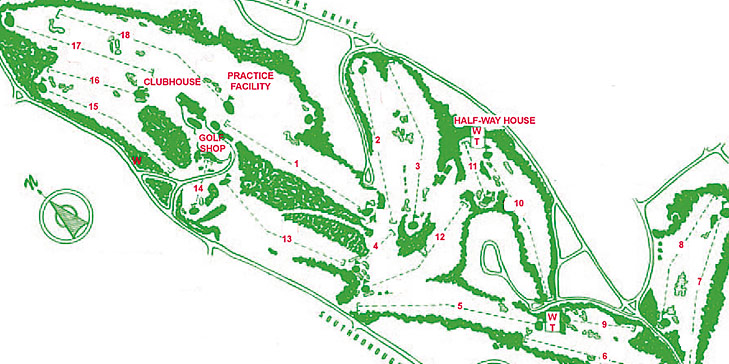Professor James Hansen, author of the recently-published biography of Robert Trent Jones Sr, argues that Jones’ role in the creation of western Canada’s greatest course was larger than previously acknowledged
Designed in the mid-1930s on a magnificent site lying above Vancouver’s north shore, Capilano Golf & Country Club in British Columbia features one of the most inspired routings in the history of golf.
Carved from 6,000 acres of heavily-forested mountainside property, much of it quite steep, the task for Canadian golf architect Stanley Thompson and his associates was to route eighteen holes up, down, and across severely sloping ground. The challenge was twofold: one, not to wear out golfers (all of whom walked in those days) with difficult climbs and, two, to present golfers with stunning vistas through majestic firs and hemlock trees down over the shimmering waters of English Bay to the city of Vancouver beyond.
The result for Capilano, in terms of combining superlative golf with wondrous landscape, was spectacular. From the clubhouse at the top of the property, the first six holes plunged over 200 feet downhill toward the blue waters of the bay. From there the remaining twelve holes moved so subtly uphill that, except for the treacherous 181 yard par three ninth, golfers barely noticed their return up the gradient, even as they traversed valleys, gullies, and ridges.
Over the years many golf historians and students of golf course architecture have credited Stanley Thompson, as one might expect, for Capilano’s routing. Tom Doak in his 1996 book, The Confidential Guide to Golf Courses, wrote: “Stanley Thompson did a shrewd job of routing the course on its steep sloping site, so that even though the first six holes play downhill toward the Lion’s Gate Bridge and the next nine tack up the hill, there aren’t any holes (other than perhaps the downhill sixth) that are just goat-hill by nature.” The members of Capilano Golf & Country Club themselves over the years have certainly been “very careful” with Thompson’s legacy, “mindful and proud of his unique bunkering and green complexes,” and always going “back to the original drawings to restore anything that might have been lost.”
But as rightfully proud as Capilano members have been to credit Stanley Thompson (1893-1953) – universally acclaimed as Canada’s all-time greatest golf architect – as its course designer, the credit for the actual routing of the golf course seems to belong, not to Thompson, but to Robert Trent Jones Sr. (1906-2000).
In 1930 Thompson, whose company was based in Toronto, took on 24-year old Robert Jones as a junior partner, creating the firm Thompson & Jones, Inc. (Jones invented his middle name “Trent” that same year, to distinguish himself from Robert Tyre ‘Bobby’ Jones, who had just won the Grand Slam.) Together in 1930-31 they designed Midvale Golf & Country Club and remodeled Stafford Country Club, both in upstate New York, near Jones’ hometown of East Rochester. They also started a 27-hole project for the General Electric Company on Carleton Island, just on the US side in the St Lawrence River, an ambitious project that General Electric soon abandoned because of the economic depression.

In 1932 Thompson dispatched Jones to Banff. Thompson had built the Banff Springs Hotel golf course at the popular mountain resort in the province of Alberta’s majestic Canadian Rockies in 1927. As with the other golf courses that Thompson had built for the Canadian railway system, notably Alberta’s spectacular Jasper Park, Thompson’s company was expected to provide an annual written report to the federal railway on the condition of the course at Banff Springs as well as any potential for improving – and if possible reducing the cost of – its maintenance. Previously this report had been made by Alan Bland of Thompson’s office. But Thompson wanted Jones to see his mountain gems and sent Robert on the long rail trip into the Rockies in the summer of 1932. At Banff, Jones sketched a number of drawings showing details of the course, including one in which he laid out a possible redesign of the famous 192-yard par three fourth hole, nicknamed the ‘Devil’s Cauldron’, which he felt could be “greatly improved by the addition of shallow traps on the right and left walls of the green slopes,” traps with “sand flashing” at “large scale” to “harmonise with the mass of the surrounding mountains.”
After finishing up at Banff, 26-year-old Trent Jones, at Thompson’s behest, went on to British Columbia, where he surveyed the pristine property – owned by British Properties Ltd, the brainchild of Vancouver entrepreneur AJT Taylor – from which Capilano Golf & Country Club would be carved. Following his visit, with the help of maps and photographs provided to him on-site and later through Thompson’s Toronto office, Jones sketched out eighteen hole-corridors for what would become the Capilano routing plant.
“I routed the holes for Thompson at Capilano,” Jones would assert many years later in his 1988 autobiographical book, Golf’s Magnificent Challenge. Not just that, as 80-year-old records now preserved in the Robert Trent Jones Sr Collection at Cornell University Archives show, Trent Jones also produced sketches for some of Capilano’s green complexes. Furthermore, he formulated the plan for Capilano’s watering system, working closely with the Buckner Company, whose pioneering slow-rotation sprinklers Jones considered to be the best in the market, staying up with Buckner’s work even during course construction so as to ensure that his irrigation plan was properly followed. Throughout the Capilano project, Jones also interacted with James Dawson of Olmsted Brothers of Brookline, Massachusetts, who had been hired to work with Thompson on the overall landscaping plan for British Properties.

If anyone would dispute Jones’ claim to Capilano’s routing plan, it would be the Canadian golf historian and Stanley Thompson biographer, James Barclay (who died in 2012). But even Barclay, in his August 2000 biography of Stanley Thompson, The Toronto Terror (Sleeping Bear Press), conceded that “Jones did the course routing for Stanley Thompson’s classic layout at Capilano.”
By the time Capilano opened for play in 1937, Thompson and Jones had mostly parted company. Perhaps that is a reason why Jones’ credit was lost. In 1935, incidentally, Thompson brought in Geoffrey Cornish, a recent Master’s graduate in agronomy from the University of Massachusetts, to evaluate soils at Capilano. Although what had become Thompson-Jones & Company would still be advertising its services as late as 1940, the dynamic working relationship between Stanley and Trent of the early Thirties lost a great deal of energy when Jones disappointed his senior partner by reneging on his promise to follow Stanley to Brazil in 1935 in pursuit of golf projects. Instead, Jones stayed at home in New York State where money and labour for public works projects was becoming more and more available thanks to President Franklin Roosevelt’s New Deal.
What evidence Thompson biographer Barclay had in hand to credit Trent Jones as the author of the Capilano routing is not clear. Whatever it was, it is supported today not only by Jones’ own direct assertion that he did the routing but by the dozens of documents and drawings now available to researchers in the Jones Collection at Cornell, which indicate the same.
Whoever did the routing plan –and it certainly now seems to have been Trent Jones – the finished Capilano layout still must be considered a Thompson masterpiece. As golf architect Dr Michael Hurdzan wrote in his 1996 textbook on Golf Course Architecture: Design, Construction & Restoration, the routing plan of a golf course, as inspired as it might be, is “like a floorplan of a building.” It takes a great deal more creativity and imagination toturn that plan into a finished work of art.
History’s judgment then should be: Trent Jones did the routing plan for Capilano but for the full brilliant fruition of Capilano the credit rests squarely with Stanley Thompson.
James Hansen is professor of history at Auburn University in Alabama. For more about the partnership between Stanley Thompson and Robert Trent Jones Sr, see Hansen’s acclaimed new book, A Difficult Par:Robert Trent Jones Sr. and the Making of Modern Golf (New York: Gotham Penguin, May 2014)
This article first appeared in Golf Course Architecture Issue 38.